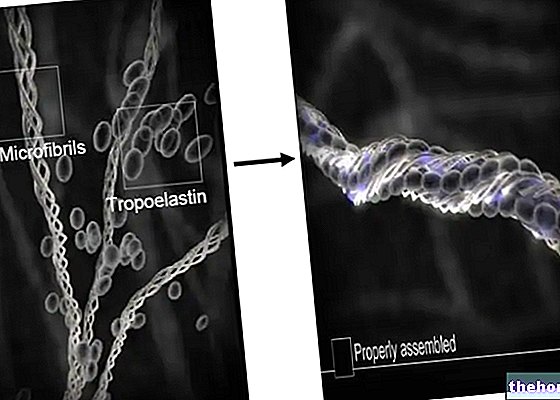Watch the video
- Watch the video on youtube
The lower female predisposition to have a beautiful abdomen therefore also depends on a possible pregnancy. Apart from weight gain, stretch marks, etc., this can separate the linea alba (as well as due to an increase in internal volume and pressure, also due to the action of certain hormones that determine the laxity of cartilage and connective tissues) and causing the aforementioned abdominal diastasis.
If on the one hand the pre-pregnancy training of the core, therefore as well as of the pelvic floor also of the abdominal girdle, is a protective factor from post-pregnancy anatomical-functional complications, on the other hand performing it early or in conditions of overt diastasis can result incorrect behavior.
This muscle, being on average made up of 50% white fibers and 50% red fibers, trains well by alternating sessions with lower repetitions with sessions with higher repetitions (series with overload at 10 repetitions and series at 20 repetitions); that said, for purely aesthetic purposes, the training to be preferred is undoubtedly that of the hypertrophic principle.
The aesthetic "quality" of the rectus abdominis is obtained, as for the other muscles, through a reasonable hypertrophy - with intense workouts that involve the greatest number of fibers, with maximum emphasis on the curvature of the spine during the flexion of the torso on the pelvis (curve more the back is possible, without relying on the legs) - and a high definition (with negative energy balance, induced by a hypocaloric slimming diet and greater energy consumption due to aerobic "lipolytic" activity.
However, it is logical that genetics also play an important role. We are not hiding behind a blade of grass but, if the goal is high - percentages of definition by fitness-model - the "epidermis must" be thin and the sensitivity of the adipose panniculus to the action of catabolic hormones high.
However, it is not enough to model only the rectus abdominis; it is also necessary to act on the obliques and the transversus.
Importance of the obliques of the abdomen
The obliques, since they are fairly easily hypertrophied, therefore widening the waist, must be trained with greater repetitions in twisting movements (torsion of the torso) at natural load; the intensity can eventually be increased a little at a time to obtain greater trophism. Lateral flexions at the cable and on a specific bench with dumbbell, as well as intense twisting during the crunch, are to be avoided in men as in women who tend to have a point muscularly wide waist.
Importance of the transverses of the abdomen
A well-calibrated tone of the transverse abdomen is essential to keep the abdomen flat to emphasize the containment action on the viscera.
Not only that, it seems that a transverse tonic contrasts the dilation of the stomach, emphasizing the sense of satiety. Since this is a muscle with an important expiratory function, it can be stimulated by carrying out a couple of seconds of forced expiration in the phase of maximum contraction during the crunch. Alternatively, the more experienced can focus on an exercise called vacuum - complex but very effective.
summing up
In summary, the muscle that gives the "checkered image" of the abdomen is the rectus abdominis, which must be trained with maximum intensity.
To reduce the waist, it is necessary to give tone to the obliques but avoiding their excessive hypertrophy; the twist with a stick "puts everyone in agreement".
Furthermore, to flatten the abdomen, the transverse must be toned up well by performing forced expirations of about two seconds in the phase of maximum contraction of the crunch; an excellent alternative is the vacuum. This leads, in some subjects - especially overweight - to a mildly anorectic effect.
At these points, in order to obtain sculpted abdominals, aerobic activity in the "lipolytic" range will be added in association with a relative low-calorie slimming diet for the reduction of adipose tissue.
For exhibitions, services or special events, which require exceptional services, we recommend reading the articles dedicated to female aesthetics, male aesthetics and the preparation of the photographic book.
For further information: General page on the anatomy of the abdominal muscles For further information: Lower abdominals to 50%, but depending on the genetics this can become unbalanced on one side or the other - the white fibers are the ones that allow us to "thicken the chess pieces". It is always she who determines the thickness of our epidermis. If thick, as it happens often in the so-called "endomorphs", you can only try to streamline and flatten, but with great difficulty and sacrifices you will be able to obtain the famous "turtle". Furthermore, again by genetics, we can have a symmetrical rectum, shorter or longer, with more or less connective dividing lines etc. It is clear that more fibers determine a greater growth potential.If you do not meet the first three points, it will already be difficult for you to develop a sculpted abdomen to a high level.
- Training: the routine for the abdomen, as anticipated, must include the classic crunches plus the inverse ones, in particular with the variant which involves a good roll of the spine and forced exhalation. Now, which protocol to adopt? Well, even in this case it depends on the condition of the subject. In principle, the abdomen that wants to grow also follows the general principles of hypertrophy. At most you could vary the number of repetitions per series, thus involving both white and red fibers. For the twist exercise, it is good to remember the correct execution and above all the intensity, in the form of speed, expressed up to failure. positive, but burns, forced, negative etc. can also be evaluated.
- Nutrition: the diet for a tortoiseshell abdomen is balanced low-calorie slimming, with a protein quantity higher than the period of hypertrophy (up to 2.2 g / kg) and lower fat, but not below 25%. Carbohydrates will be around 50% - only less if the calories are really low, but be careful not to overdo it.
- Integration: we do not recommend particular supplements for this purpose, if not generic and necessary ones - possibly a multimineral and vitamin. A possible answer in the definition can give the belnd of beta-stimulants such as guarana, caffeine, cocoa alkaloids, theophylline, bitter orange etc. (ephedrine is now no longer over the counter), thyroid stimulants (guggulsterones and forskolin, if available) and alpha blockers such as yohimbee (also removed from the Italian market. However, caution is recommended, since beta-stimulants are not "fresh water." Make sure with your doctor that you have a healthy cardiovascular system and do not use them for more than a few weeks. According to some, even the thermogenic creams, applied on the abdomen, have given encouraging results (taking the above points for granted).
Watch the video
- Watch the video on youtube




























